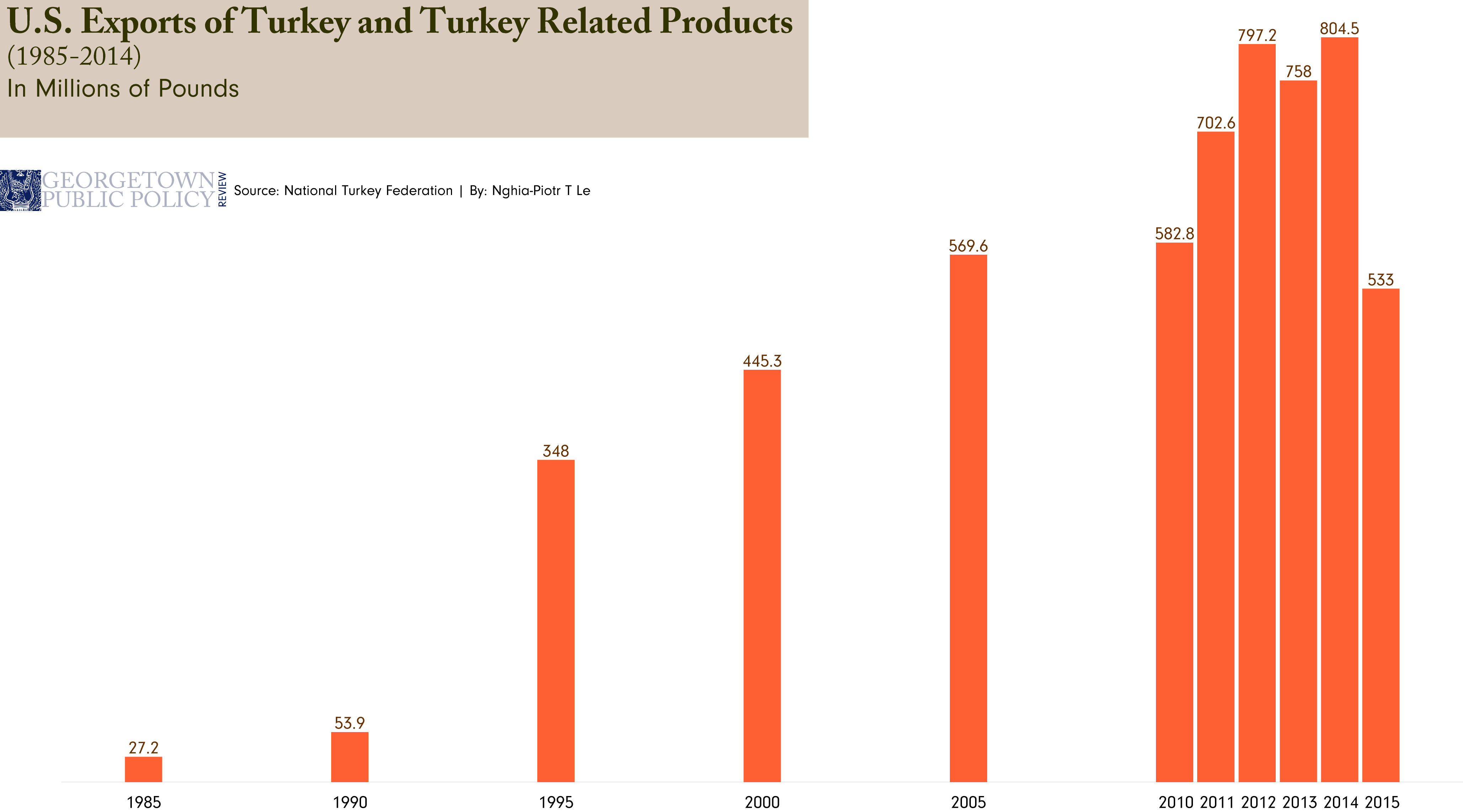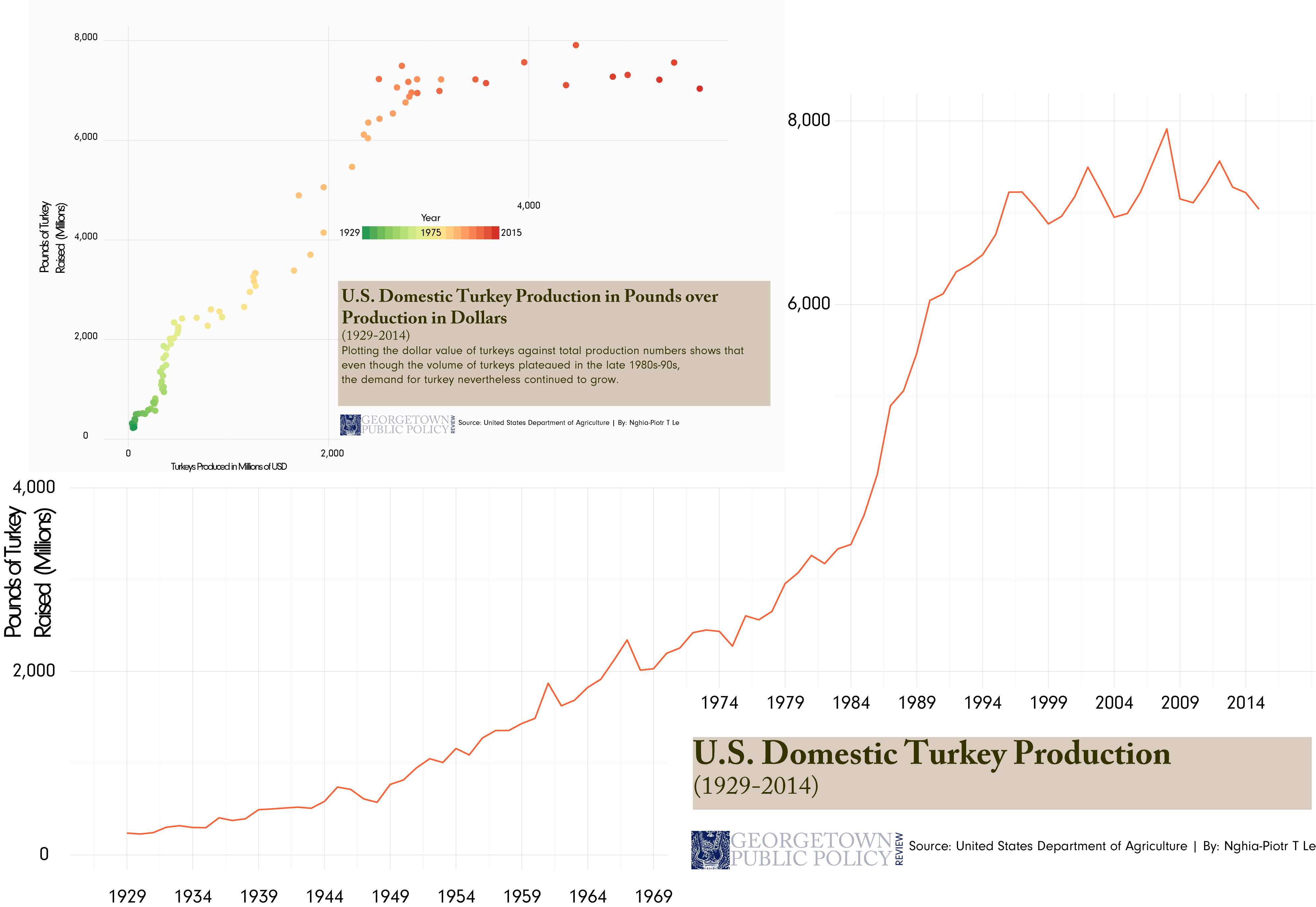As Americans celebrate Thanksgiving, some are left to wonder how the turkey—a large not particularly flavorful bird occupies so much attention as the symbol and centerpiece of Thanksgiving. Further, where are all these turkeys coming from if they only gain relevance seemingly one month per year? Quite counterintuitively, the turkey is not merely a cultural symbol for the U.S., but an economic one as well.
Benjamin Franklin once proposed to his daughter that the turkey be the official bird of the United States. Though symbolically the eagle edged out the competition, the turkey has had greater and far-reaching economic impacts, as the US is the world’s largest producer and exporter of the bird.
Crunching the numbers, in 2015, per capita consumption in the US hovered at around 16 pounds while total turkey production yielded about 7.04 billion pounds from 233 million turkeys raised. The US ranks third in turkey consumption, behind Israel and Hungary, but domestic consumption increases annually. The US Department of Agriculture predicts per capita consumption will increase by 6 percent at the end of 2016, which is significantly higher than the 2.4 percent, 1.6 percent, and 0.5 percent forecasted growth for beef, chicken, and pork, respectively.

However, the holiday season alone does not account for the rising demand for turkey in the US. Rather, products such as deli meat, turkey bacon, jerky, and increasingly, ground turkey, have accounted for a growing share of the overall turkey demand since the 1970s as health concerns regarding red meat consumption have led more people to source lean protein. The switch to turkey meat has been so significant that the Butterball company initiated a campaign calling those who have swapped to this protein turketarians, and this marketing tactic worked so effectively that the term has now been officially coined in Urban Dictionary.
Growing popularity notwithstanding, turkey has long been eaten in the US. The Europeans prior to their arrival had already been consuming turkey after the Spaniards brought it back from Mexico, where the wild turkey was first domesticated. Turkey represented a popular meat to share given its large size, and was eaten as a special occasion food before President Abraham Lincoln announced Thanksgiving as an official holiday in 1863. The codification of Thanksgiving thus solidified turkey as the key centerpiece on most everyone’s Thanksgiving table.
The transition of turkey from a holiday food mostly for the wealthy class to a near universal staple at any deli counter, and increasingly as an alternative to ground beef, arose largely because of the bottom line. As expected, turkey producers traditionally saw sales spike around Thanksgiving and Christmas, but had minimal sales the rest of the year. In 1910, consumption of turkey was around 0.8 pounds per year.
However, a push by the industry starting in the early twentieth century to encourage consumers to switch to turkey meat as a healthy alternative through recipe booklets, posters, advertisements, and other consumer education materials worked effectively to push turkey into the top five meats consumed in the US, especially as food and health started to become inextricably linked in American minds toward the latter half of the twentieth century.

The success of the turkey industry can also be attributed to the vertical integration of the market controlling the entire production process, including the marketing that has swayed consumer preferences. Moreover, the consolidation of the industry over the past few decades has also meant fewer operations in business, but enhanced productivity. In 1975, 180 hatcheries averaged 33,000 eggs per hatchery; in 2007, the number of hatcheries dropped to 55, but they each produced 704,000 eggs.
Turkey producers not only look to satiate domestic demand for the bird, but also have an export-oriented view. Mexico represents the number one trading partner in turkey meat, generally accounting for more than 50 percent of exports by volume. The North American Free Trade Agreement (NAFTA) has no doubt assisted this trade relationship by reducing import tariffs to near zero. However, producers have started to turn to other countries, and have especially concentrated their efforts on East Asia (and perhaps rightly so given the precariousness of NAFTA under the forthcoming presidential administration). Further helping the export industry, is the American predilection for white turkey breast meat, which allows producers to use the remaining dark meat for export.
The industry is not without its problems – chief among them avian flu, which affected sales in 2015 after producers culled some 50 million birds. Although the market has largely bounced back and turkey growers have restocked their farms, the susceptibility of turkeys to diseases will remain an issue for the industry moving forward. Furthermore, the turkey industry experienced a shock to its burgeoning ground turkey sector after its major processor, Jennie-O Turkey Store, recalled nearly 55,000 pounds of frozen, raw turkey burgers in 2015 because of salmonella contamination. Jennie-O Turkey Store has been the most vocal proponent of ground turkey, and it currently holds a 40 percent share of this category.
Despite these recent problems, the turkey market remains a fairly robust and productive sector because it retains a cultural status and symbol that simply cannot be replaced by another meat; after all, no other animal lends itself as well to finger tracing.
Jessica Li is pursuing her masters in international development policy at McCourt. Prior to graduate school, she worked for close to four years in DC as an editor at a consulting company contracting primarily with the US Agency for International Development on agricultural development projects. She has also worked overseas in Shanghai managing the book publishing division of a media company. Her policy area interests include social inequality and access.
